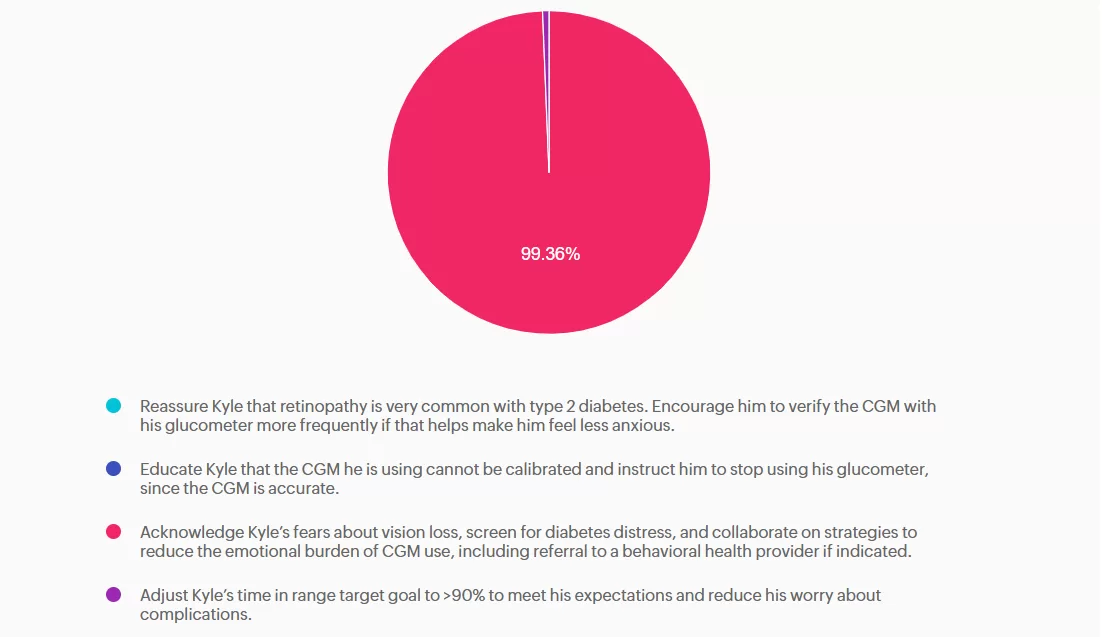For last week’s practice question, we quizzed participants on Diabetes Tech and Diabetes Distress. 99.36% of respondents chose the best answer. We want to clarify and share this important information, so you can pass it on to people living with diabetes and your colleagues, plus prepare for exam success!
Before we start though, if you don’t want any spoilers and haven’t tried the question yet, you can answer it below: Answer Question

Kyle is a 55-year-old man with type 2 diabetes for ten years. He was recently diagnosed with retinopathy in both eyes. His grandmother lost her eyesight due to diabetes. Due to this family history, he is very concerned about his new diagnosis. He uses a Libre continuous glucose monitor (CGM) to monitor his blood sugar levels. During your visit, he is preoccupied with checking his Libre CGM and tells you that he uses his glucometer to verify CGM readings at least four to six times per day. When you ask him about this, he reports that he can’t focus on his work or home life if he isn’t over 90% time in range.
As a diabetes care and education specialist, what is the best approach to this situation?
- Reassure Kyle that retinopathy is very common with type 2 diabetes. Encourage him to verify the CGM with his glucometer more frequently if that helps make him feel less anxious.
- Educate Kyle that the CGM he is using cannot be calibrated and instruct him to stop using his glucometer, since the CGM is accurate.
- Acknowledge Kyle’s fears about vision loss, screen for diabetes distress, and collaborate on strategies to reduce the emotional burden of CGM use, including referral to a behavioral health provider if indicated.
- Adjust Kyle’s time in range target goal to >90% to meet his expectations and reduce his worry about complications.

Getting to the Best Answer
Answer A is incorrect: 0% chose this answer, “Reassure Kyle that retinopathy is very common with type 2 diabetes. Encourage him to verify the CGM with his glucometer more frequently if that helps make him feel less anxious.” This is incorrect. Although diabetes retinopathy is a common complication of diabetes, it is not inevitable, and the risk can be reduced by maintaining optimal glycemic control. Additionally, verifying blood glucose levels with a glucometer when there appears to be no issue with his CGM will not alleviate his anxiety.
Answer B is incorrect: 0% chose this answer, “Educate Kyle that the CGM he is using cannot be calibrated and instruct him to stop using his glucometer, since the CGM is accurate.” This is incorrect. Though his particular CGM cannot be calibrated, fingerstick blood glucose readings are the gold standard when CGM readings are unexpectedly out of range.
Answer C is correct: 99.36% chose this answer, “Acknowledge Kyle’s fears about vision loss, screen for diabetes distress, and collaborate on strategies to reduce the emotional burden of CGM use, including referral to a behavioral health provider if indicated.” This is correct. Kyle is demonstrating symptoms of diabetes distress due to fear of ocular complications, perfectionism, and technology overwhelm. The ADA Standards of Care 2025 recommend routine screening for diabetes distress and other psychosocial concerns at least annually or when complications arise.
Answer D is incorrect: 0.64% chose this answer, “Adjust Kyle’s time in range target goal to >90% to meet his expectations and reduce his worry about complications.” This is incorrect: The time in range goal for most adults living with diabetes is >70%. Adjusting his time-in-range goal to >90% will not work to reduce his obsessive behavior.
We hope you appreciate this week’s rationale! Thank you so much for taking the time to answer our Question of the Week and participate in this fun learning activity!
Get 30% Off Your Entire Order!
From November 30th to December 2nd, use the code “Cyber30″ for 30% off at checkout!
Save the date and shop our sale









